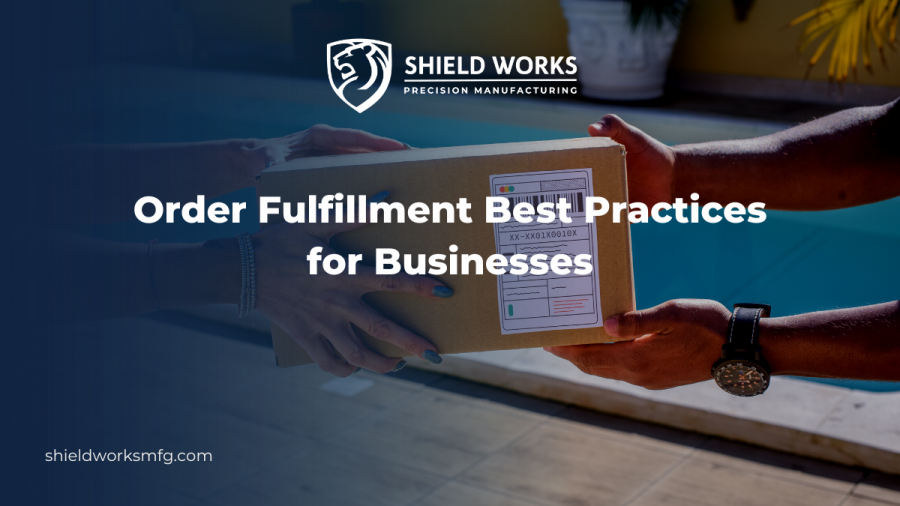Order Fulfillment Best Practices for Businesses

Sixty-nine percent of online shoppers say they are less likely to shop with a retailer if their order arrives more than two days late. On top of that, 14% of online shoppers say they would take their business elsewhere if their order delivers late just once. There are so many important steps that happen between placing an order and delivery. If you don’t have an efficient order fulfillment process in place, you could risk losing customers. Keep reading to learn more about best practices and how to improve your processes.
Tips and Best Practices
Order fulfillment is a crucial part of your business’ success and continued growth. There will be challenges along the way, but there are things you can do to improve your processes. Below are several strategies and best practices that will lead to satisfied customers.
Streamline Receiving
Make sure you process incoming shipments quickly. Take note of any damaged goods and return them to the manufacturer for immediate replacement. This will make it easier to keep items in stock and keep your customers happy.
Organize Your Warehouse Efficiently
Place your best-selling items in the front of your warehouse. This will give pickers easy access and allow them to get orders out faster. Organize the rest of your inventory based on demand, with the least popular items in the back of the warehouse.
Optimize Your Inventory
Make sure the amount of inventory you hold matches the demand. If you don’t have enough inventory, you could run out of stock, causing delays in product fulfillment. If you have too much inventory, you might not be able to offload all of it, increasing your storage costs
Choose the Right Order Picking Strategy
An efficient order picking strategy will help improve your warehouse order fulfillment. Evaluate how many orders come in every day and how many staff members you have to pick orders to determine the best strategy. Two common picking strategies are discrete order picking and batch order picking. With discrete order picking, one order is picked at a time. With batch order picking, several orders are picked at a time.
Automate Your Processes
Automate as many of your processes as you can. With manual operations, you run the risk of human error. This can hurt your order fulfillment performance which can hinder growth.
Integrate Data Systems
Enhance your order fulfillment process by integrating with your suppliers. Having access to the same data helps get orders out faster. It also keeps your suppliers accountable for shipping the correct items to your warehouse.
Prioritize Shipping and Logistics
Shipping partners play an essential role in order fulfillment. Negotiate the best shipping rates and delivery schedules for your customers. Make sure you always have a backup plan for shipping. While a certain carrier might be reliable most of the time, that doesn’t mean that things will never go wrong. You don’t want your orders to be delayed because you didn’t think ahead.
Manage Customer Expectations
Set expectations with your customers about when they will receive their orders. If there are any shipping delays or other issues, notify the customer right away. Open lines of communication are essential to keeping your customers satisfied.
Prepare for Returns
Returns are inevitable, especially when it comes to e-commerce fulfillment. Rather than handling returns on a case-by-case basis, implement a standard return policy. This will improve customer satisfaction and help you account for the extra inventory. Include a return label with every order for easier processing. Make sure to have quality control checks as part of the return process. If a customer returns an item because it’s malfunctioning, you need to ensure that the item doesn’t get restocked by mistake.
Types of Order Fulfillment Models
While there are best practices you can follow, there isn’t a one-size-fits-all model for order fulfillment. There are a few different common models, each with its own pros and cons.
In-House
In-house order fulfillment means that all steps are completed internally. This model allows you to manage the entire process from end to end and is a good solution for small businesses. As your business grows, in-house order fulfillment can start to become too much to manage.
Outsourcing
Under this model, warehouse management is outsourced to a third party. This takes a lot of work off your plate and frees up your staff to work on other tasks. It’s also helpful because you don’t have to worry about storing your inventory yourself. One of the downsides of outsourcing is that you give up control over your order fulfillment. Also, outsourcing only works well for stocked items, not custom or made-to-order products.
Drop shipping
Drop shipping is when an order is produced and shipped by the manufacturer. This is a good choice for e-commerce companies because it helps keep overhead costs down. It also helps save your customers money by cutting out the middleman. Like outsourcing, drop shipping takes control of order fulfillment away from you. Also, shipping times might be longer if the manufacturer is in a different country than your customer base.
Hybrid
With a hybrid method, you use a combination of these models. For example, you might fulfill popular products in-house and outsource everything else. This model gives you the flexibility to fulfill your orders in a way that will help both your business and your customers.
Work With A Trusted Partner
Order fulfillment is crucial to customer satisfaction, so it’s important to get it right. There are plenty of best practices you can follow to improve your processes, but at the end of the day, you need to do what’s right for your business. Shield Works offers a wide range of services, including warehousing and fulfillment. We’re the trusted partner you need to take your business to the next level. Contact us today and let us know how we can help your business.
